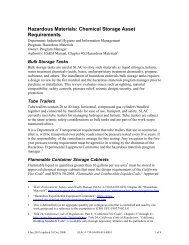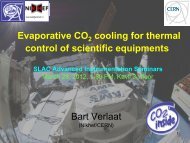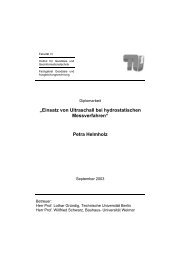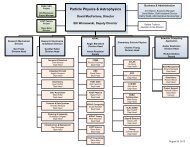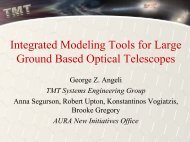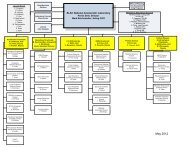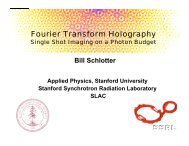BES - SLAC Group/Department Public Websites - Stanford University
BES - SLAC Group/Department Public Websites - Stanford University
BES - SLAC Group/Department Public Websites - Stanford University
You also want an ePaper? Increase the reach of your titles
YUMPU automatically turns print PDFs into web optimized ePapers that Google loves.
FYO7 <strong>SLAC</strong> S CIENCE AND T ECHNOLOGY S ELF E VALUATION<br />
bodies in the solar system, programs that map the outer regions of the Milky Way, and searches for<br />
faint optical transients on a wide range of time scales. The LSST concept has been repeatedly<br />
endorsed as a priority US scientific initiative by national advisory groups and reviews, including the<br />
most recent NAS/NRC Astronomy and Astrophysics Research Committee (“Astronomy and<br />
Astrophysics in the New Millennium,” 2001) and the influential “Quarks to the Cosmos” Committee.<br />
In September 2005, the NSF awarded four-year funding for the LSST design and development effort,<br />
with a view to advancing LSST construction to Major Research Equipment and Facility Construction<br />
(MREFC) “new start” status in FY 2010.<br />
LSST would provide detailed constraints on the nature of dark energy, through several distinct and<br />
complementary techniques. Four of these techniques: measurement of baryon acoustic oscillations;<br />
surveys of clusters of galaxies; photometry of Type 1a supernovae; and measurement of cosmic shear<br />
using weak gravitational lensing, were highlighted in the Dark Energy Task Force (DETF) report<br />
commissioned by the AAAC and High Energy Physics Advisory Panel (HEPAP). The DETF report<br />
concluded that no single technique alone is both sufficiently powerful and well enough established to<br />
yield the necessary constraints, but that the combination of all four (as provided by LSST) is<br />
especially compelling. The DETF indicated that a Stage IV Large Survey Telescope (modeled on<br />
LSST) could make a major advance in our understanding of dark energy. On the basis of the DETF<br />
report, and its own evaluation of the project, the P5 subcommittee of HEPAP recently recommended<br />
that DOE-OHEP initiate a program of R&D on LSST, leading to a CD-2 review in FY09.<br />
A large team from the astronomy and particle physics communities is pursuing the LSST concept.<br />
LSST would be developed as a multi-agency public/private partnership, with NSF as the lead agency<br />
providing the bulk of telescope, site, and data management funding, and DOE-OHEP supporting the<br />
fabrication of the LSST camera, with members of the particle physics community providing data<br />
handling and science analyses. Private and/or international funding, some of which is already inhand,<br />
will enable production of the telescope mirrors, which are long-lead, expensive items that must<br />
be started before federal funding for proposed construction is officially authorized.<br />
LSST will produce an enormous volume of data, roughly 30 terabytes per night, leading to a total<br />
database over its ten years of operation of several tens of petabytes. Processing such a large<br />
database—and archiving it in useful form for access by the community—is a major challenge for the<br />
project. The data management system is configured in three “layers:” an infrastructure layer<br />
consisting of the computing, storage, and networking hardware and system software; a middleware<br />
layer, which handles distributed processing, data access, user interface, and system operations<br />
services; and an applications layer, which includes the data pipelines and products, and the science<br />
data archives.<br />
Collaboration: <strong>SLAC</strong> leads the R&D program for the LSST camera, and plays a key role in<br />
including other high energy physics groups: BNL, LLNL, ORNL, Harvard <strong>University</strong>, the <strong>University</strong><br />
of Pennsylvania, Brandeis <strong>University</strong>, the <strong>University</strong> of Illinois at Urbana-Champaign, Purdue<br />
<strong>University</strong>, Ohio State <strong>University</strong>, the Rochester Institute of Technology, the <strong>University</strong> of California<br />
at Santa Cruz, the <strong>University</strong> of Cincinnati, and Wayne State <strong>University</strong>.<br />
Leadership: <strong>SLAC</strong> Professor Steven Kahn is the Deputy Director of the LSST Project and the Lead<br />
Scientist for the camera, while <strong>SLAC</strong> Physicist Kirk Gilmore is the Camera Project Manager. In<br />
addition, <strong>SLAC</strong> scientists and engineers have taken lead technical roles in the camera thermal and<br />
mechanical design, as well as in the calibration strategy for the telescope.<br />
Objective 1.4 Provide for Effective Delivery of Science and Technology<br />
Over the last year, significant progress has been made in key aspects of the camera design: (1)<br />
Prototype sensors have been acquired and successfully tested. (2) A detailed design of the camera<br />
body and mechanisms has been developed and modeled to demonstrate conformance with tight<br />
mechanical and environmental constraints. (3) A complete thermal analysis has been performed and<br />
evaluated.<br />
F I N A L P A G E 3 7





